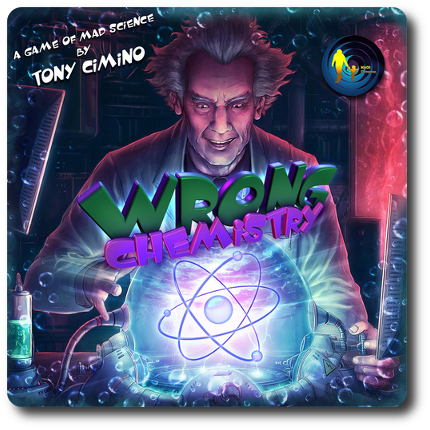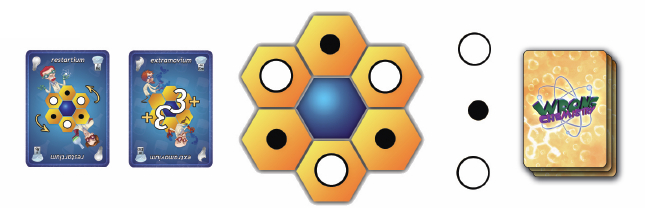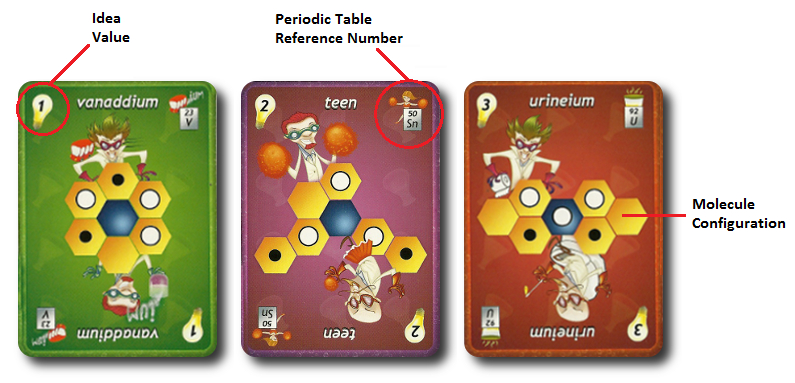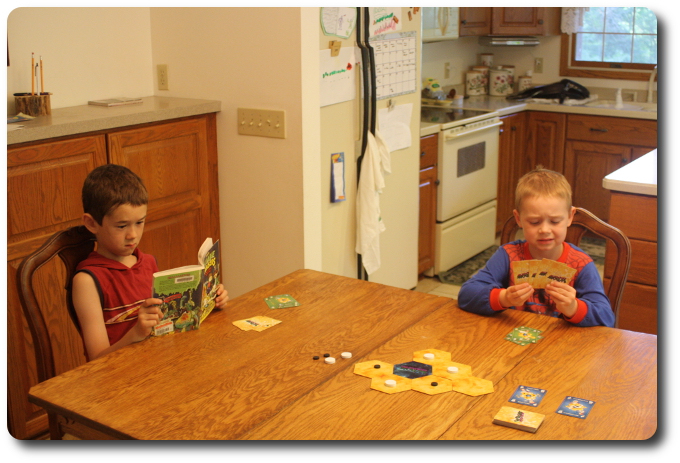
The Basics:
- For ages 5 and up (publisher suggests 8+)
- For 2 to 4 players
- Approximately 30 minutes to complete
Geek Skills:
- Counting & Math
- Logical & Critical Decision Making
- Pattern/Color Matching
- Hand/Resource Management
Learning Curve:
- Child – Easy
- Adult – Easy
Theme & Narrative:
- Experimentation is the key to success and victory!
Endorsements:
- Gamer Geek mixed!
- Parent Geek mixed!
- Child Geek approved!
Overview
Albert Einstein, a German-born theoretical physicist, once said, “No amount of experimentation can ever prove me right; a single experiment can prove me wrong.” In this game, players will be attempting to duplicate molecule configurations. If the match is 100% accurate, the miracle of science is made visible to everyone. But it’s not that easy. Molecular bonds are hard to keep together, especially when sharing a lab with other scientists!
Wrong Chemistry, designed by Tony Cimino and published by Mage Company, is comprised of 1 Center hex tile (one side blue, one side grey), 6 Outer hexe tiles (one side yellow, one side grey), 9 wooden discs (5 white, 4 black), and 54 Element cards. The game components and illustrations are bright, colorful, and humorous. The icons used in the game are easy to interpret and the entire game is made of high quality components.
Lab Set Up
To set up the game, first place the Center hex tile, blue side up, in the middle of the playing area.
Second, place the 6 Outer hex tiles, yellow side up, around the Center hex tile so that one side of each Outer hex tile is adjacent to one side of the Center hex tile.
Third, place one wooden disc on each Outer hex tile, alternate the colors with the end result being a ring of wooden discs with a black/white pattern surrounding the Center hex tile. Place the remaining wooden discs off to one side of the playing area to create a disc pool. They will be used during the game.
Fourth, find the “Restartium” and “Extramovium” Element cards and set them next to the game playing area, face-up. Shuffle the remaining cards and place them face-down. This is the draw deck. Leave room next to the draw deck for a discard pile. When completed, your game playing area might look something like the following.

Fifth, deal 4 Element cards to each player, face-down.
Sixth, all the players now place 1 Element card in front of them, face-down. All the face-down Element cards are then revealed and the player with the smallest numerical value (referred to as the “Periodic Table Reference number”) found in the upper right corner on the card’s face is the first player. All the revealed Element cards played are gathered and placed face-up next to the draw deck to create the discard pile.
Seventh, each player is dealt 1 more Element card to bring their hand size back up to 4 Element cards.
That’s it for game set up. Get ready to experiment!
In the Name of Science!
Wrong Chemistry is played in turns with no set number of turns per game. A player’s turn is comprised of 2 steps. These steps are summarized here.
Step 1: Take Actions
By default, each player is given 4 points (referred to as “energy” in the game) at the beginning of their turn. These points are spent to take actions. Any of the following actions can be taken multiple times and in any order as long as the player has points to spend. Note that a player is never required to use all their points, but they cannot save them for a later turn, either.
- Remove 1 White Disc: For one point of energy, the player can remove 1 white disc from any hex tile. The removed white disc is placed back in the disc pool.
- Remove 1 Black Disc: For one point of energy, the player can remove 1 black disc from any hex tile. The removed black disc is placed back in the disc pool.
- Add 1 White Disc: For one point of energy, the player can place 1 white disc onto 1 hex tile that does not contain any other disc. The disc must come from the disc pool.
- Add 1 White Disc: For one point of energy, the player can place 1 black disc onto 1 hex tile that does not contain any other disc. The disc must come from the disc pool.
- Move 1 White Disc: For one point of energy, the player can move 1 white disc that is currently on a hex tile to any other hex tile that does not contain a disc.
- Move 1 Black Disc: For one point of energy, the player can move 1 black disc that is currently on a hex tile to any other hex tile that does not contain a disc.
- Move 1 Yellow Outer Disc: For one point of energy, the player can move any 1 yellow Outer hex tile to any other adjacent hex tile as long as the yellow Outer hex tile being moved does not currently have a wooden disc on it. Note that a player can never move the blue Center hex tile during the game.
- Discard 1 Card: For one point of energy, the player can discard one of their Element cards in their hand to the discard pile.
Additionally, there are two special actions the player can take.
- Use “Extramovium” Element: For one scored Element card of any value, the player gains an additional 3 points to use on actions. The Element card used is sent to the discard pile. A player does not use a point to activate the “Extramovium”.
- Use “Restartium” Element: For one point of energy and usable only once per turn, the player can reset the game playing area back to its original configuration. This is the same configuration the game set up created. Once the player uses the “Restartium”, it’s tipped to one side to signify it has been used.
At anytime during the player’s turn, a player can score an Element card. The molecule configuration on the Element card must match the configuration of the hex tiles and wooden discs found in the game playing area, regardless of the player’s sitting position. When scored, the player places their Element card out in front of them so all the players can quickly review it to ensure it correctly matches the current configuration. It’s then placed face-up in front of the player creating their score pile or returned to the player’s hand if found to be an incorrect match.

Step 2: Draw and Reset
The second and final step a player takes allows them to draw back up to a maximum of 4 cards and reset the “Restartium” Element card back to its upright position. This ends the player’s turn. The next player going clockwise now has their turn starting with step 1 above.
Eureka!
The game continues until a player cannot draw back up to 4 cards during step 2 of their turn. The game then immediately ends and all remaining cards in the players’ hand are discarded. The players then score their points using the Element cards in the player’s score pile. Each of the Element cards has a number value in an image that looks like a light bulb. This is the card’s “Idea value”. The Idea values (that range from 1 to 3) are added together.
If the player has 3 or more Element cards with Periodic Table Reference number values in a sequential order, the player is awarded 1 extra Idea value for every card in the sequential run. For example, a run of 3 Element cards would award the player 3 extra points to their overall score.
The player with the most points wins the game.
House Rule
About half of our Parent and Gamer Geeks found the current rules available in the game to be in need of repair. The following house rule was created to correct what some thought was broken.
- End Game Based on Element Cards in Score Pile: Instead of playing the game until one player cannot draw up to 4 cards during step 2 of their turn, play until one player either has a total of 15 points in their score pile or has a total of 15 Element cards in their score pile. Not both. If playing to 15 points, the first player to obtain 15 points wins the game. If playing to 15 Element cards, the game ends as soon as a player collects their 15th Element card. The players then count their points as normal to determine the winner of the game. If either of the two endgame conditions are used, the game still ends as normal if a player cannot draw up to 4 cards at the end of their turn.
To learn more about Wrong Chemistry, visit the game’s web page.
Prediction
Simple matching games are always good for the younger Child Geeks, but seldom please older Child Geeks, Parent Geeks, and the Gamer Geeks. While pattern matching and recognition is essential to mental development, it isn’t much of a challenge for a more experienced mind. Unless there is a game involved, that is. And Wrong Chemistry does bring to the table an interesting game of pattern matching and recognition.
For the Child Geeks, I predict Wrong Chemistry will be well received, but initially frustrating. I believe the inexperienced player will immediately attempt to create the most basic of Molecule configurations based on their lowest scoring Element cards with total success. But the complexity of the more difficult Molecule configurations will most certainly have them in a bit of a mental tissy. Since a player can only take actions on their turn, anything the player attempts to set up could be completely altered by the time the player has their next turn. I think that’s where we will start to see the “Restartium” Element card and the “Extramovium” Element card used a great deal. Used and abused. There’s a point where both cards quickly result in diminishing returns for the players. I think the more experienced players will recognize this early on, but our younger players will fixate on the need to create one Molecule configuration at a time instead of looking at the game’s “big picture”. After all, it doesn’t matter how many Molecule configurations a player completes. Only the points that each is worth is of importance at the end of the game.
For the Parent Geeks, I believe Wrong Chemistry will please some and be of little interest to others. As I said, Wrong Chemistry is at its core a simple pattern matching game. But it’s also very casual and allows for a lot of social activity at the table without upsetting the game’s speed or a player’s need to concrete. Indeed, a player could walk away from the table after taking their turn and come back to the table again without any fear of possibly missing anything. This is because all a player can do when it ‘s not their turn is to helplessly watch the Molecule configuration shift. That’s going to irritate some of the Parent Geeks, but others will find it useful when they need to get up from the table and figure out why the little geeks have suddenly become very quiet in the next room.
And you just know if it’s going to irritate some of the more “gamer” Parent Geeks, it’s going to flat-out frustrate some or all of the Gamer Geeks. But I hold out hope. While a very simple game from the perspective of a Gamer Geek, it does allow for some casual game play that might be enjoyable (or at the least, tolerable), making Wrong Chemistry perfect for a game filler or a “final game of the evening” offering. Then again, it might totally flop.
Teaching Wrong Chemistry is a very simple exercise. In fact, all we ever did was quickly demonstrate the actions the players could take and then let the players have the game. Wrong Chemistry is very intuitive and none of our players, from the very young or the very old had any issues understanding the basic principles of the game and its rules. The only question we were ever asked was if it was possible to keep using the “Extramovium” Element card during a player’s turn. The answer is, “yes”, but we also made certain that players understood that it cost 1 Element card in the player’s score pile (of any Idea value) for the privilege to do so.
Having taught the game to my oldest Child Geeks, I felt satisfied that they both understood how to play the game after only 5 minutes of explanation. I have no doubt that my 5-year-old will be able to play Wrong Chemistry without issue. While the game publisher suggests that the game is suitable for ages 8 and up, Wrong Chemistry doesn’t require its players to read, and what little math is involved in the game can be done by an older player without reducing the fun for the younger. At most, a younger player might have a slight disadvantage when it comes to making runs using the Periodic Table Reference number values. But I doubt any points earned from such a monumental feat would be insignificant or game changing in any way. So, before we set out to do some science, I asked my two little geeks their thoughts on Wrong Chemistry so far.
“I like the idea of the game, but this looks too easy for me.” ~ Liam (age 8)
“I like it! This is a good game for me because I’m going to be a scientist when I grow up!” ~ Nyhus (age 5)
Looks like my little geek scientists are ready to test my theories when it comes to the overall endorsement of the game. Let’s put Wrong Chemistry in a beaker and see if we can’t create magic or disaster.
Final Word
It would be incorrect to suggest that the Child Geeks disliked Wrong Chemistry, but the level of fun they had with it was based primarily on who they played the game with. When the older Child Geeks played the game with younger Child Geeks, the level of enjoyment was fairly mixed. The younger Child Geeks became frustrated with the inability to score big points and the older Child Geeks were frustrated with the younger Child Geeks for taking so long during their turns. The perfect games were with those Child Geeks who were around the same age and experience level. The games moved along at a quick pace and none of the players ever felt outgunned or overly slowed down. When the perfect mix was finally found, the game was awarded the Child Geeks’ approval.

As my 5-year-old grits his teeth in frustration, his older brother quietly waits for his turn…
The Parent Geeks had mixed feelings about Wrong Chemistry. The less experienced non-gamers and more casual Parent Geek game players enjoyed Wrong Chemistry and found it to be an entertaining game to share with their peers and at the family gaming table. Parent Geeks did notice the downtime between plays when their Child Geeks played with them, but they didn’t seem to care. What they did care about was the game’s overall length of play that seemed a bit too long at times. Which brings us to the some of the negatives that the more “gamer” Parent Geeks noted. The game’s length, for them, felt too long. According to one Parent Geek, “A good enough game, but I felt it overstayed its welcome for about 10 or so minutes.” Most Parent Geeks agreed that a single game should not take anymore than 15 or so minutes and felt that an average game length of 30 minutes was just a bit longer than necessary. And then there was the constant resetting and shifting of the wooden discs and hex tiles. This frustrated all the Parent Geeks, but only the more “gamer” Parent Geeks found it to be irritating enough to warrant the game getting their disapproval when it came time to provide their personal endorsement. According to one Parent Geek, “I enjoy the game when I am actively playing it, but the downtime between turns and the inability to set anything up for my next turn just left me cold.” But not all the voices heard at the gaming table were negative. One Parent Geek who really enjoyed Wrong Chemistry stated, “This is a perfect game for me and my friends. It’s easy to learn, easy to play, challenges me, and like how I have to think about what is the best bang for my buck when it comes to building molecules. Great game!” In the end, the Parent Geek group was unable to resolve their differences when it came to the overall endorsement of the game. This resulted in a mixed bag of positive, neutral, and negative feelings about the overall game playing experience.
The Gamer Geeks were also mixed, surprisingly enough, but they did all agree on a few major points. First, all the Gamer Geeks thought the game was too long. They suggested that the game end when players had scored so many points or had a specific number of Element cards in their score pile. This would make the game much more strategic and interesting, from their point of view. The House Rules in this review cover this new rule if you care to use it. Second, they really didn’t care for the fact that their presence at the gaming table was otiose when it wasn’t their turn. They saw this as unnecessary and unwelcomed downtime. According to one Gamer Geek, “I can take my turn, go walk the dog, and come back without missing anything.” After that, the Gamer Geeks parted ways with some going to the camp that firmly believed that Wrong Chemistry was not a Gamer Geek’s game and the others suggesting that the game was just fine for what it was. According to one of the Gamer Geeks who voted to approve the game, “This is a simple game – no one is saying otherwise – but I think it would be perfect for a game filler or a late night game when I want to keep gaming but don’t have the brain power left to think too hard.” In the end, the Gamer Geeks just couldn’t come to a consensus. Some believed the game should be skipped and others thought the game had a place at their gaming table.
Wrong Chemistry is a mixed bagged for me, too. While I enjoy the challenge of organizing the hex tiles and the wooden discs to get big points, I rather dislike the downtime, the game length, and the inability to use any strategy or tactics to help my future turns. It simply doesn’t matter what you do on your turn because it can all be reset by the next player. This means I was always left with using the current state of the game as my base, but even then, I could always reset it myself. Which, honestly, makes me something of a hypocrite. At times I hated the ability offered to the players that allowed them to reset the game playing area and other times it was the first action I took without hesitation.
One aspect of the game that I found interesting was the seldom used action that allows the players to discard a card. I did this a lot, especially when I had Element cards worth 3 points. I dropped those faster than a hot potato. While they are worth big points, they often times just took up a valuable spot in my card hand. I found that the best mix was to keep my hand full of small Idea value cards which allowed me to score just about every turn. More times than not, I won the game, too. Of course, it didn’t take long until the other players caught on to my little tactic and then any advantage I had was quickly gone.
As a Parent Geek, I enjoy the game. My 5-year-old loves playing it with me and I’m pretty sure my 8-year-old does, too, although he sometimes looks disinterested when he is waiting for this turn. We fixed this by inviting him to read or do something quiet at the table while he waited. I’m teaching my little geeks that it’s rude to just walk away from the table unless it’s for important reasons like using the restroom, getting a drink, or just the simple need to get up and stretch after sitting for a long period of time. It’s my hope that my little geeks will be seen as “polite and well-manner players” at any gaming table they sit at. We’re not there yet, but we’re working on it.
As a Gamer Geek, I could take or leave Wrong Chemistry. It’s not a bad game, but I think there are more interesting card games that play in the same amount of time and allow me to use more tactics and strategy. After playing it once, you’ve seen the game. The only additional depths you can hope to explore is trying to figure out mathematically the point of diminishing returns when it comes to using Element cards to pay for the “Extramovium” action. I would, however, eagerly sit at the gaming table if Wrong Chemistry was offered late at night or as a quick filler.
In the end, I would suggest Wrong Chemistry to non-gamers and casual game players. I was also asked if this would be a good game to introduce to students in chemistry class. I didn’t think it would be. While the game’s theme does suggest chemistry, it has little to do with it. This is a pattern matching game that just happens to use words that sound like real elements on the Periodic Table. And that’s not science or even educational when it comes to strengthening a player’s basic understanding of chemistry. But, to be fair, if the goal is to get younger players interested in chemistry, I suppose Wrong Chemistry could be positioned as a fun introduction to how molecules can be shifted to create new elements. For example, the game could be used to make the abstract chemical bond properties a bit more concrete and easier to understand. But then again, maybe not. Wrong Chemistry has no real working scientific lessons to teach other than the simple fact that chemistry could be fun. And if the game sounds like fun to you, do give it a try and see if you can create some enjoyment at your gaming table with family and friends.
This game was given to Father Geek as a review copy. Father Geek was not paid, bribed, wined, dined, or threatened in vain hopes of influencing this review. Such is the statuesque and legendary integrity of Father Geek.




Pingback: Wrong Chemistry: Element Game Expansion Review » Father Geek
Pingback: Wrong Chemistry: Scientist Game Expansion Review » Father Geek
Pingback: Wrong Chemistry: Expand Your Lab Game Expansion Review (prepublished version) » Father Geek